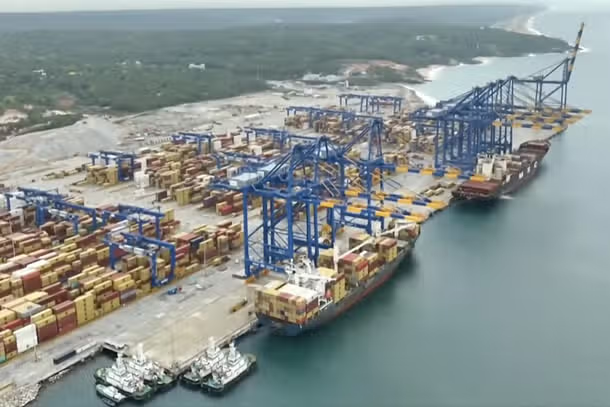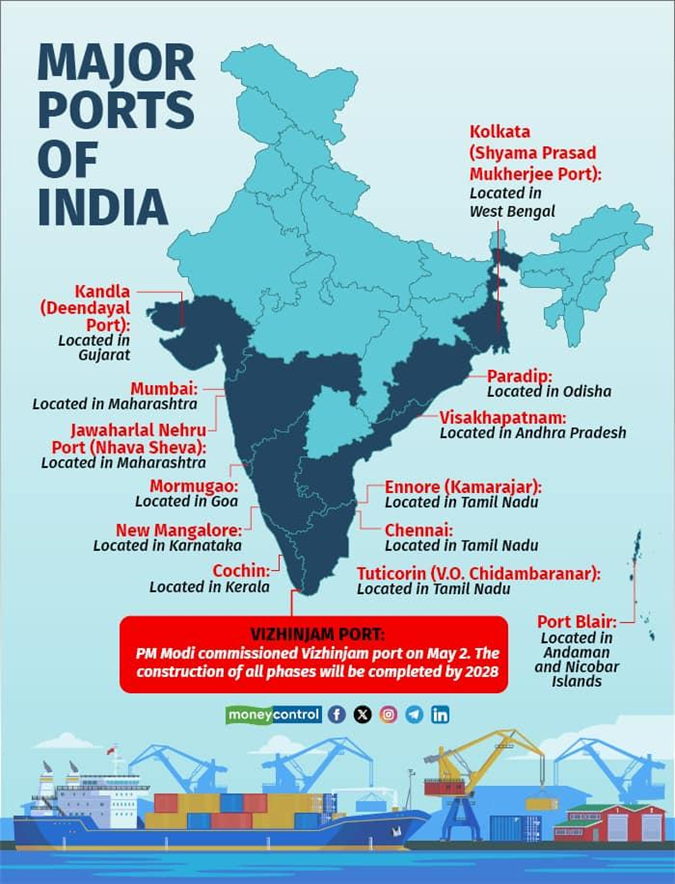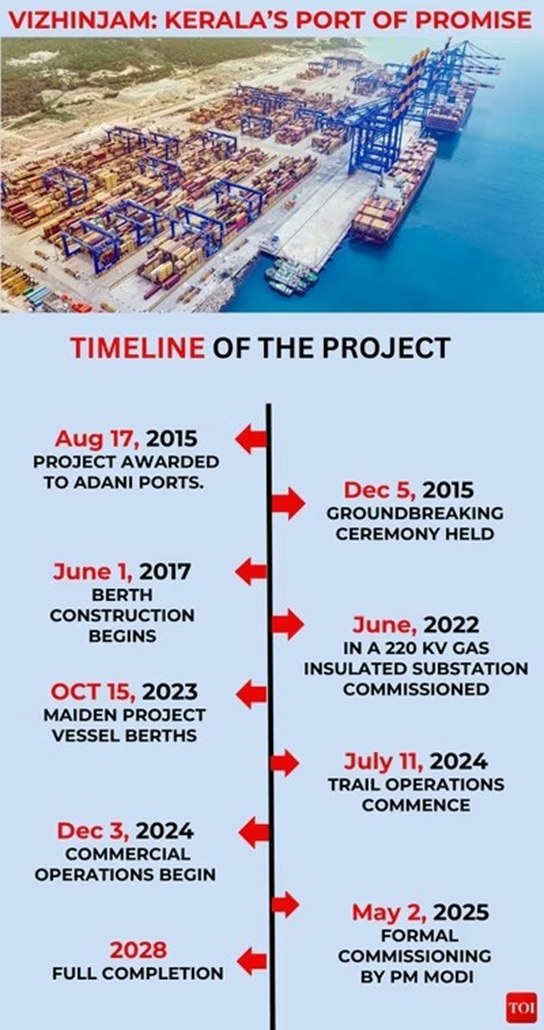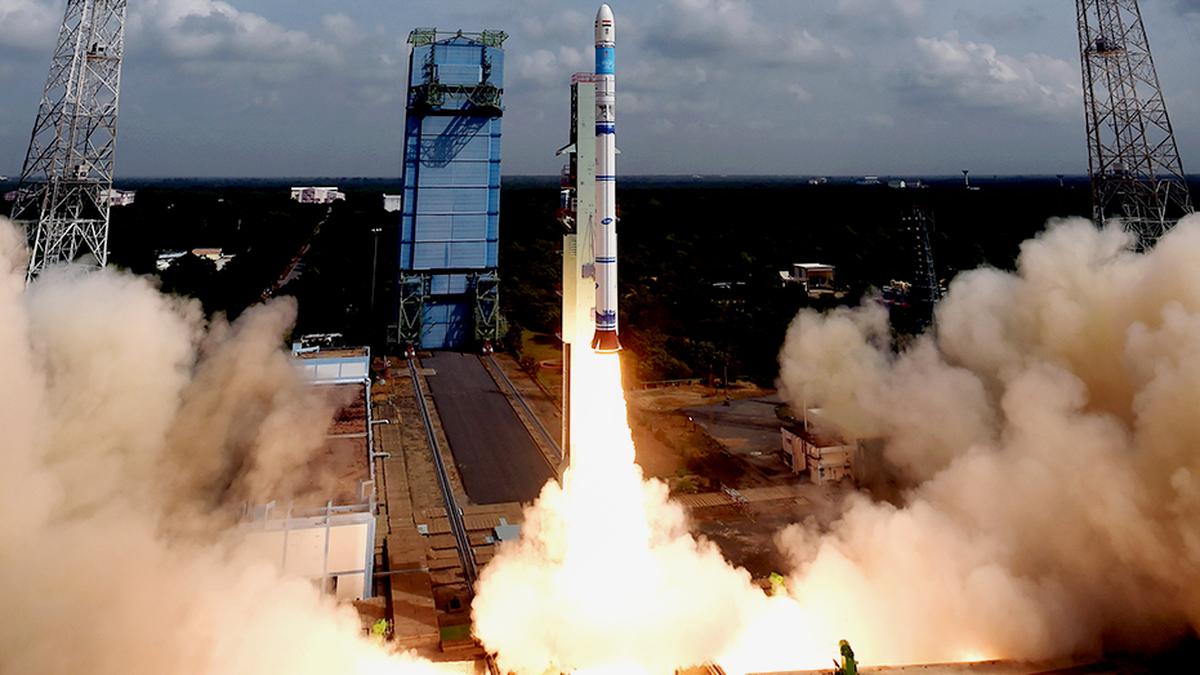- Courses
- GS Full Course 1 Year
- GS Full Course 2 Year
- GS Full Course 3 Year
- GS Full Course Till Selection
- Answer Alpha: Mains 2025 Mentorship
- MEP (Mains Enrichment Programme) Data, Facts
- Essay Target – 150+ Marks
- Online Program
- GS Recorded Course
- Polity
- Geography
- Economy
- Ancient, Medieval and Art & Culture AMAC
- Modern India, Post Independence & World History
- Environment
- Governance
- Science & Technology
- International Relations and Internal Security
- Disaster Management
- Ethics
- NCERT Current Affairs
- Indian Society and Social Issue
- NCERT- Science and Technology
- NCERT - Geography
- NCERT - Ancient History
- NCERT- World History
- NCERT Modern History
- CSAT
- 5 LAYERED ARJUNA Mentorship
- Public Administration Optional
- ABOUT US
- OUR TOPPERS
- TEST SERIES
- FREE STUDY MATERIAL
- VIDEOS
- CONTACT US
Vizhinjam Port : India’s 1st Dedicated Container Transshipment Port
Vizhinjam Port : India’s 1st Dedicated Container Transshipment Port

- In May 2025, The Prime Minister of India inaugurated the ₹8,800 crore Vizhinjam International Deepwater Multipurpose Seaport in Kerala.
- It is India’s first transshipment hub dedicated to transshipment.
- It is aiming to reclaim a large share of cargo that currently gets routed via Sri Lanka’s Colombo port.
- It will allow India to handle global cargo directly.
- It is also the first semi-automated port in the country and is equipped with an AI-powered vessel traffic management system developed in collaboration with IIT Madras.

About Vizhinjam Port

Key Features:
- Location: Near Thiruvananthapuram, Kerala.
- Developer: Adani Ports and SEZ Ltd in partnership with the Government of Kerala.
- The Kerala government has borne two-thirds of the total cost, including funding for the 2.95 km breakwater.
- Natural Depth: Nearly 20 metres, ideal for mega container ships.
- Proximity to Global Route: Located just 10 nautical miles from the East-West international shipping route.
- Vizhinjam is now part of the MSC’s Jade Service route, connecting Singapore to Europe, marking a key milestone in India’s maritime ambitions.
- The port will be connected via NH 66 and a new railway link, and Kerala’s first cloverleaf interchange is being developed to handle future logistics traffic.
Strategic Importance:
- Reduces reliance on foreign ports such as Colombo, Singapore, and Dubai.
- Decreases logistics costs and turnaround times for Indian exporters and importers.
- Enhances India’s standing as a maritime hub in the Indian Ocean Region (IOR).
Current Status of India’s Port Sector
1. Port Infrastructure
- India has 13 Major Ports under central administration and 200+ Minor Ports under state governments.
- Major Ports are governed by the Major Port Authorities Act, 2021.
- Minor Ports are governed by the outdated Indian Ports Act, 1908.
2. India's Maritime Profile
- India is the 16th largest maritime nation in the world.
- Ports handle 95% of India's international trade by volume and around 70% by value.
- India is strategically located along key global trade routes, giving it potential as a transshipment hub.
Significance of Port Economy in India’s Growth
- Ports are critical trade gateways that enable faster and cost-efficient import-export of goods.
- A robust port sector enhances export competitiveness and reduces the trade deficit.
- Ports generate large-scale direct and indirect employment in logistics, transportation, and warehousing.
- The government allows 100% FDI under automatic route for port infrastructure, attracting global investment.
- Ports integrate with multi-modal logistics networks—including road, rail, and inland waterways.
- They are essential for the development of Coastal Economic Zones (CEZs) and industrial clusters.
- Ports contribute to government revenue through customs duties, service charges, and port fees.
Achievements in the Port Sector
1. Capacity Expansion
- Cargo handling capacity at major ports has increased to 820 Million Metric Tonnes (MMT), a 47% growth since 2014.
- Overall port capacity has doubled to 1,630 MMT.
- India aims to achieve 10,000 MMT capacity by 2047.
2. Key Mega Port Projects
- JNPT (Jawaharlal Nehru Port) has surpassed 10 million TEUs (Twenty-foot Equivalent Units) in container handling.
- Vadhavan Port in Maharashtra is under development to be India’s largest container port.
- Galathea Bay Port in Great Nicobar aims to become a major international transshipment hub.
3. Operational Efficiency
- According to the World Bank’s Logistics Performance Index 2023, India improved its ranking to 22nd in International Shipments, from 44th in 2018.
- Turnaround time of vessels has reduced to 0.9 days.
- Container dwell time has reduced to 3 days.
- Nine Indian ports were listed in the World Bank’s Container Port Performance Index 2023.
- Visakhapatnam Port ranked among the top 20 globally.
Challenges in India’s Port Sector
- Many minor ports lack modern facilities, mechanisation, and deep berths.
- Absence of advanced container handling technology hampers growth.
- Poor planning and insufficient equipment result in long waiting times, especially at busy ports like Nhava Sheva.
- Dual control of major and minor ports leads to inefficiency and fragmented governance.
- The Indian Ports Act, 1908 is outdated and does not align with current economic goals.
- Many ports, especially on the east coast, suffer from siltation, reducing their operational depth.
- Despite digitisation, cargo inspections and documentation are often delayed due to lack of coordination.
Government Initiatives and Reforms
1. Green and Digital Initiatives
- Harit Sagar Guidelines promote sustainable and environmentally friendly ports.
- Sagar Setu App helps simplify cargo clearance and logistics management.
- National Logistics Portal (Marine) is a digital platform to bring all stakeholders under one roof.
2. Legislative Reforms
- Major Port Authorities Act, 2021 provides autonomy and corporate governance models for major ports.
- Marine Aids to Navigation Act, 2021 modernises vessel navigation.
- Indian Vessels Act, 2021 ensures legal uniformity across inland waterways.
3. Strategic Vision Plans
- Maritime India Vision 2030 aims to develop world-class mega ports, transshipment hubs, and modern logistics systems.
- Sagarmala Project focuses on port-led development, coastal connectivity, and reducing logistics costs by leveraging India’s maritime location.
Way Forward
- The Indian Ports Act, 1908 must be replaced with a modern law that supports private participation and innovation.
- Upgrade non-major ports with modern berths, container scanners, and cargo-handling automation.
- Invest in smart port systems using IoT, blockchain, and AI.
- Expand rail and road links to reduce bottlenecks between ports and industrial zones.
- Create predictable policy frameworks to attract more private capital and expertise in port development.
- Ensure end-to-end electronic documentation, real-time tracking, and automated inspections to reduce delays.
Conclusion
The commissioning of Vizhinjam Port is a landmark event in India's maritime development journey.
It reflects India’s vision to become a self-reliant, globally competitive hub for international shipping.
With reforms, modernisation, and integration of port infrastructure, India can lower logistics costs, enhance trade efficiency, and strengthen its strategic position in global supply chains.
A robust port economy will be a key pillar in achieving the goal of a $5 trillion economy and positioning India as a leading blue economy.
|
Also Read |
|
| Public Administration Optional | |
| UPSC Monthly Magazine | Question Answer Practice For UPSC |




